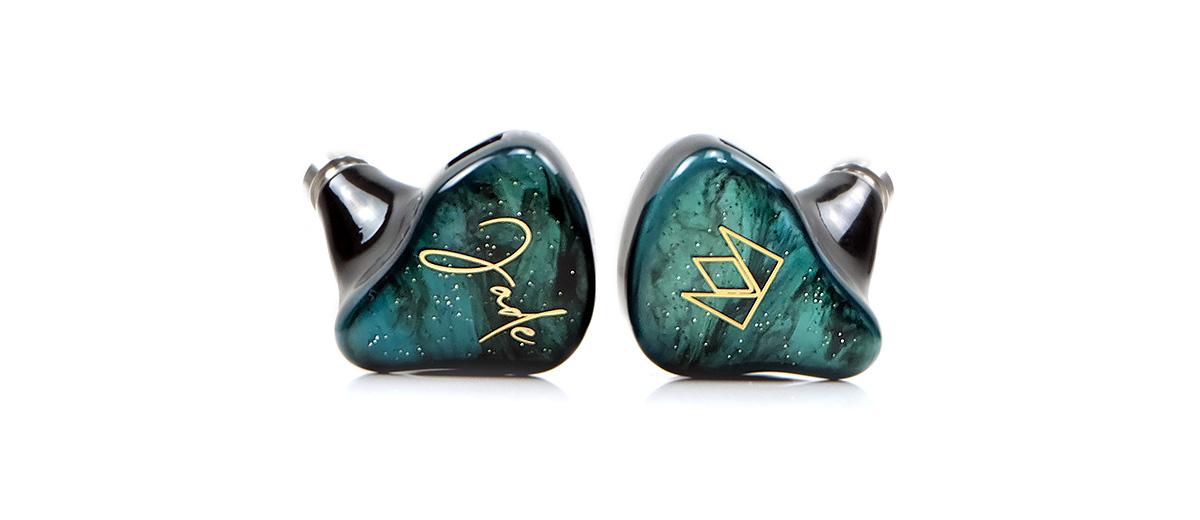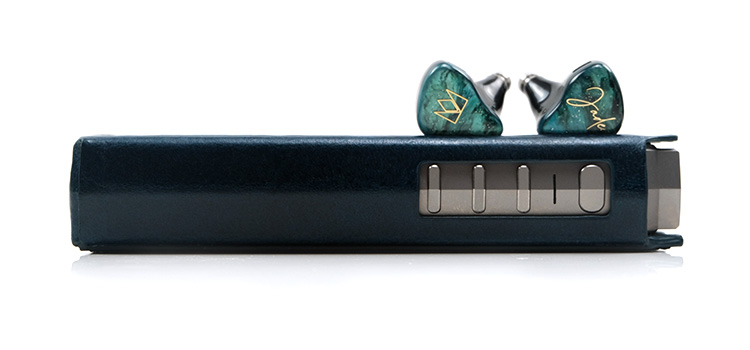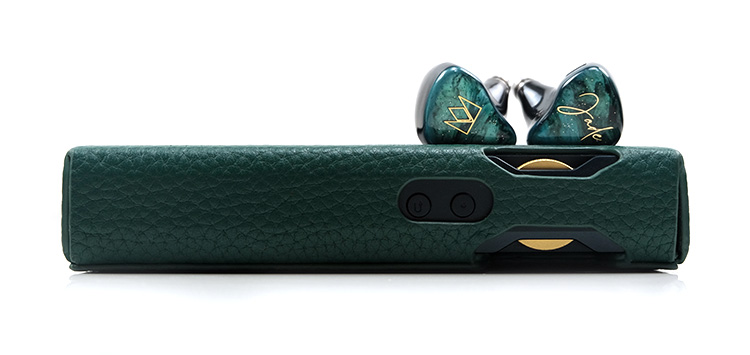Sound Impressions
Summary
Like the TUX 5, the Jade is built for enjoyment and listening with an energetic and lively sound signature rather than outright reference monitoring.
Unlike the TUX 5, the Jade is less about the lows and highs with a more balanced and flexible W-shaped response curve. It accentuates what I like to call the key touchpoints in audio; an exuberant low-end, a prominent pinna gain, and a smattering of treble sparkle.
To that end, the staging dimensions are more focused on delivering excellent depth and power with vocals front and instrument positioning just tucked in behind a little. It is a pleasing match for modern rock and pop, anything with a vocal focus that needs to be front and center, particularly male rock vocals.
The overall coloration is warm to neutral, more of a natural and easy-on-the-ear type of timbre with a slight softening of the leading edges and not a huge amount of overt sibilance or splashiness coming through.
It’s not a dull upper mids sound by any means but if you prefer your percussion with a lot of fizz and presence the likes of the Kublai Khan or even the BA Kadence tuning might be more to your tastes.
Tips and sources will have an influence. My personal choice was the single flange red stem silicone tip combined with the Cayin N8ii though other DAPs had their pros and cons, (see pairings further down). This combination offered the liveliest performance with an improved treble presence over the other tips.
Frequency Response
The Jade tuning is mostly w-shaped though the bass curve is less sub-bass biased compared to the TUX 5 with a strong mid-bass influence around 50-100Hz delivering a bit more energy and punch than absolute rumble.
Bass to lower-mids scoop is not that exaggerated either. The lower mids instrumental presence is good with nothing sounding horribly thinned out or pushed too far back. From around 1-3k the pinna gain is quite strong so anything hitting this range is going to sound up close and lively.
The treble 5-8k range is not as pushed forward as the TUX 5 so there is less of a bass and treble contrast through the mids. It’s there but a little smoother and more evenly balanced. I suspect there is a bit of a dip somewhere in the upper mids around 4-5k that takes some of the string out of any potential upper treble energy also.
I would not say the Jade is the airiest of monitors I have tested, at least compared to the likes of the Kadence, Ragnar, and Kublai Khan. It has more of a natural attenuation with a little bit of an 8k push.
Timbre
The Jade has a likable instrumental and vocal timbre. One that has a slight even-harmonic bias and an energetic bass fundamental performance underpinning it.
It’s not a smoothed-over sound but those Sonion drivers seem to do quite well with sibilance. It successfully avoids sounding too thin and brittle so notes will come across as a bit thicker and more rounded in tone compared to the TUX 5 and Kadence.
It works really well with vocal performances that sound full-bodied but with a slightly liquid leading edge and zero sharpness to prevent performances from sounding fatiguing.
The bass is also dense and dynamic with an excellent upfront and punchy character. EDM lovers should have no problems enjoying the low-end despite it having a little less rumble compared to the TUX 5.
Personally, I feel it comes across as a little livelier with that improved mid-bass punch so whilst EDM works great, modern rock kick drums and rhythm guitar chords have better body and impact also.
Staging & Dynamics
As mentioned the key touch points in the Jade presentation are more aggressive and upfront in their imaging. It’s a slightly simpler soundstage arrangement and not as wide or open sounding as Noble’s higher-end models.
That means the bass response and anything over that 1-3k range is going to come to the fore and that is where your ear is going to be drawn to. Everything else is slightly tucked in behind supporting those two key elements. A mildly rising lower-mids also gives supporting instruments some decent presence so they do not sound too diminished sub-1k.
There is something of an upper treble element but it’s not pushed too hard, more for flavor and preventing the Jade headroom from being cut off and the mids lacking in air.
It’s a weighty low-end and one you will definitely pick up on with heavy-handed EDM bass mixes but not one that goes all out for sub-bass power with the mid-bass punch drawing about even if slightly ahead.
The width is moderate, as is the intricacy of the layering and imaging. Do not expect Kadence levels of complexity though I did find some sources did better with spatial cue separation such as the RS8 and the N8ii using its Class AB solid-state mode which works the Jade treble energy a bit more.
Synergy
Efficiency
Since specs are light and there is very little color commentary by Noble on sensitivity and impedance we assume from the outset that the Jade is rated at less than 35Ω and sensitive enough to use with normal source players.
We do have one fully-rated Noble IEM in the line-up we can benchmark against, the Viking Ragnar. This was reviewed a number of months ago and is rated at 17Ω impedance and 112dB @1kHz SP. When compared to the Jade it is definitely less sensitive when attempting to volume match as well as the allowable volume range for comfortable listening.
But how about the other Noble monitors with no listed specs? From testing with the HiBy RS8 and the Cayin N6ii with the R01 Motherboard, we can establish that the Jade is leaning more towards the sensitive side of the line-up but is not super sensitive.
For example, the all-BA 8 driver Kadence is more efficient by some distance compared to the Jade. That should not be surprising given the declaration from Noble themselves that the Kadence is one of their most sensitive monitors to date.
Compared to the triple driver Zephyr, the Jade is actually a few steps more sensitive on a low gain balanced output setting with the RS8 though the gap is not huge. I would say 5-8 volume steps depending on your personal listening preference.
The original TUX 5 does seem to be almost the exact same specification for efficiency when compared to the Jade. Both are 5-driver single dynamic and 4 BA driver designs so it is perhaps unsurprising.
Pairings
How you pair the Jade will largely depend on whether you want to accentuate the strengths in its pinna gain and low-end emphasis or aim for an improvement in its staging capability, particularly in treble height and width.
Out of the four DAPs tested one fell directly into the first category and one fell into the second category. The final two DAPs straddled both but one of them did much better on the midrange and treble timbre.
Play To The Strengths
The first one was the Luxury & Precision P6 Pro. The Jade treble extension is good but not exaggerated and will not have the same sparkle as the Kadence, Kublai Khan, or even the older TUX 5. It’s a little smoother than that with a staging quality that is rounded rather than expansive.
The P6 is not going to really do too much with the treble compared to the other DAPs which have a bit more presence with the Jade pairing. What it will do is offer the best midrange texture for that prominent vocal imaging. Of the four, it sounded the most detailed and natural and properly supported also but a rich and vibrant bass response.
Go For Resolution
The HiBy RS8/Jade pairing fell into the second category. It sounds more neutral with vocals pulling back a bit but you do get more headroom, treble presence, and superior staging width. The layering and acoustical arrangement benefit from that with the Jade mids sounding more complex and complete.
The only caveat from the above is that the RS8 does not quite capture the vibrancy of the Jade tuning for high-energy audio recordings. It’s more for acoustical works in my opinion.
Try For Both
The Cayin N8ii does all of the above for me and is my top choice for pairing with the Jade, especially in Solid-state Class AB mode with the P+ mode which gives it some excellent dynamic range combined with a soaring, albeit more euphonic vocal and treble performance. The staging is improved as a result though its vocal texture is a shade behind the P6 Pro.
The N6ii with the R01 motherboard does very well on the lows and highs though the mids upwards timbre is a little thinner. That might work though for those that need a bit more contrast and sparkle in their recordings from the Jade tuning.
It is not as reserved as the RS8 for PRaT either so it’s a handy choice that pairs well with the Jade for less money than the flagships.




